Downtowns serve as the lifeblood of communities, embodying vibrant businesses, engaged citizens, cultural events and employment opportunities. Downtown Sioux Falls thrives today thanks to the tireless efforts of past generations in both city government and the business community. They collaboratively set the stage for what we now enjoy. However, there are indications that city and business leaders may not be paying enough attention to the needs of our downtown today.
Historical Background
In Sioux Falls, community leaders and elected officials have used various approaches over the last six decades to advance downtown interests, with a particular focus on the Big Sioux River and the Falls.
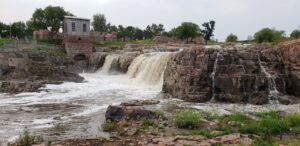
Early settlers were drawn to the area by the Falls, establishing their businesses around this natural attraction. Those producing pollution situated their operations in the area of the Falls, downstream from where the population lived.
Neglected Beauty
In 1920, city park commissioner Fred Spellerberg saw the beauty and potential of the Falls. He lamented the fact it was surrounded by a “mote of industry” blinding the public from an “appreciation of their interest and beauty.” His vision of opening up the Falls to the public was spot on. It eventually became one of the most popular places to visit in Sioux Falls. But it took strong leadership, vision and hard work to get there.
River Rehabilitation
In the mid-60s, the community started to do something about the neglected Falls and river. In 1969, RISE (River Improvement Study and Evaluation), a non-profit organization, was formed. Two key players in RISE were Roy Nyberg and Hazel O’Connor. Over the following decade, volunteers cleared away debris and garbage, transforming the riverbanks from eyesore to asset. From Western Avenue to the Falls, they removed everything from old car bodies to appliances from the river channel.
Urban Renewal Challenges
In the 1970s, federally funded urban renewal efforts were underway around the country. Urban renewal was a federal program to clear out slums in big cities to allow redevelopment. Unfortunately, this program created problems in downtown Sioux Falls.
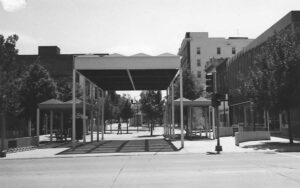
The poorly timed downtown mall hastened the flight of retail to the Western Mall in the 1970s
A pedestrian mall on Phillips Avenue was built in 1974 as part of our local urban renewal program, permanently blocking car traffic. The timing couldn’t have been worse. Following national trends, downtown retailers were already migrating to the Western Mall and west 41st Street. The pedestrian mall hastened the unavoidable flight of retailers to the suburbs.
The River Greenway Emerges
Also in 1974, newly elected Mayor Rick Knobe with support from parks commissioner Earl McCart, hired Steve Metli as the city’s planning director. Metli was charged with creating a plan for the river. Their vision led to the creation of the Sioux Falls River Greenway. This initiative aimed to establish scenic and recreational paths along both sides of the 20-mile river loop around the city. Federal funding, coupled with local support, transformed the river from a liability into a major city asset.
The Downtown Development Corporation
Recognizing that federal urban renewal programs were ineffective, and downtown was struggling, city and business leaders decided to act. The Downtown Development Corporation (DDC) was founded in 1978, funded by a who’s who list of prominent local business leaders to revitalize the downtown core. City government endorsed the private effort, acknowledging that they had done about all they could to encourage redevelopment downtown.
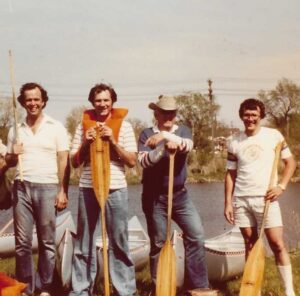
Steve Metli, Larry Fuller, Buck Moore and Dick Brown surveyed the Big Sioux River by canoe in 1979
A Trip Down the River
On June 25, 1979, a group from the DDC took a canoe trip from Yankton Trails to what is now the Cherapa Place and Raven Industries location downtown. On the trip were city planner Steve Metli, Larry Fuller, Buck Moore, Dick Brown and an Argus Leader photographer. DDC president, Buck Moore, reportedly said “The future of downtown Sioux Falls and the Sioux Falls River Greenway have great opportunities ahead and there will be a time where commercial business, retail and major housing developments will be taking place on both sides of the Big Sioux River downtown.” He went on to predict downtown “would become a centerpiece and destination for all citizens and visitors to this great city.”
A second canoe trip included Mayor Knobe, Dave Christensen and T.J. Reardon. All expressed appreciation for what the River Greenway project could do for downtown and the community.
Success for the Downtown Development Corporation
The DDC quickly succeeded in getting downtown moving forward once again. In just a few years, several big buildings were constructed downtown including the Western Surety building at 9th and Phillips and the IBM building at 8th and Phillips. Those projects helped start to reenergize downtown. The DDC had accomplished its mission.
In the early to mid-80s the DDC took over the downtown merchants group, the Sioux Falls Business Association, in an effort to reenergize it. That helped set the stage for the next downtown organization.
Main Street Sioux Falls
Main Street Sioux Falls was established in 1988, focusing on retailers and downtown property owners. It introduced a business improvement district and a façade improvement program to encourage property owners to refresh the exterior of their buildings. I served as the last president of the DDC and the first president of Main Street. I worked with Mike Crane who had succeeded Dick Brown as the executive director of the DDC. Carl Kaden was the first executive director of Main Street.
Shifting City Focus
In 1987, Sioux Falls community and business leaders changed their focus. The Chamber of Commerce and Sioux Falls Development Foundation created Forward Sioux Falls, shifting the city’s attention to marketing the city as a whole and the development of industrial parks. Downtown was no longer on their radar.
Enhancing the Visitor Experience
Downtown Sioux Falls is thriving, but it is not perfect. With a bit more attention and investment, it could be much better. Thousands of visitors come downtown throughout the year. What they may notice are broken up sidewalks, broken down curbs, hard to see crosswalk markings, neglected landscaping and other evidence of inattention.
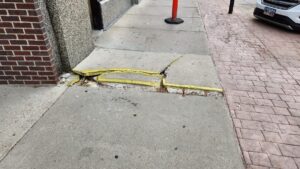
Downtown pedestrians had to deal with this broken sidewalk on Phillips most of the summer
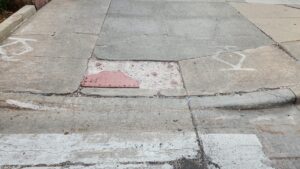
This transition area from sidewalk to street on Phillips is crumbling
Community resources should be allocated to enhance the visitor experience downtown. It should be tidy and well cared for. The city could implement higher design standards and regular infrastructure maintenance to improve the experience for downtown’s crowds.
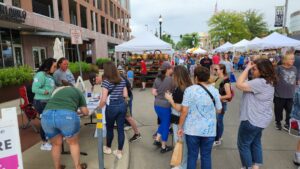
The Pavilion area and south Phillips routinely attract thousands of daily visitors
Today’s community leaders must recognize the investment their predecessors made to create the downtown they’ve inherited. They have a responsibility to sustain and improve it. Downtown needs their time, attention and investment.
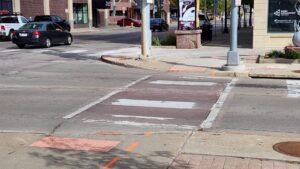
This busy crosswalk at 11th and Phillips only gets repainted every three years
DTSF’s Limited Role
The DTSF organization plays a crucial but narrow role, primarily focused on retail. While it must be part of discussions regarding downtown, other stakeholders with greater resources and influence should also be actively involved. Downtown is the heart of our community and an incredible economic development tool.
Downtown Needs More Attention
Of course, there is a great deal of focus right now on the wonderful new developments being built in north downtown. Meanwhile, the rest of downtown sometimes suffers from inattention.
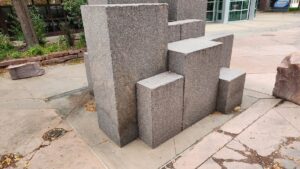
Missed opportunity – This water fountain on the Federal Courthouse Plaza hasn’t worked in years
I would like to see Forward Sioux Falls, Experience Sioux Falls and the city be more actively involved in managing and improving downtown. The heart of our city could be even better if the city’s business and economic development organizations would devote more time and attention to it. And the city should again provide much needed leadership to make downtown as good as it can be for businesses, visitors and residents.
“Thousands of visitors come downtown throughout the year. What they may notice are broken up sidewalks, broken down curbs, hard to see crosswalk markings, neglected landscaping and other evidence of inattention.” This is ALSO a problem visible at each of the municipal area interstate highway interchanges on the surface streets, and elsewhere on our major paved arteries such as West 12th Street, South Minnesota Avenue, etc. All our out-of-town visitors who arrive by car have to pass through these neglected public areas on their way to see DTSF. Given the significant improvement/development/attention that has been given DTSF in recent years, I believe other public areas of Sioux Falls are in need of renewed focus as to upkeep and grooming.
Joe, This is one blog I can totally agree with. So much work has gone into the revitalization of the downtown area but a visiter must be appalled at the condition of the streets, sidewalks and facades and wonder if the area is really as great as we all say it is.
Thank you for presenting this issue. I hope it generates serious discussion and immediate action.
The City has installed MULTIPLE 15 minute parking stalls, along 11th Street and 10th Street and I believe other areas, which require vehicles to have the flashing lights on and the time limit is enforced 24 hours a day. They seem to be taking the place of Loading Zone stalls which were restricted until 6:00pm. Many people, especially senior citizens, avoid downtown because of parking access to stores and restaurants. Now there are fewer stalls available. My observation is these new 15 minute stalls are rarely in use during the day and early evening.
Nice blog Joe! I wholeheartedly agree with your thoughts regarding downtown! Yes, the growth, economic development, eating and drinking establishments, sculpture walk, etc have created a fabulous boost for the area but the aesthetics need improvement. These certainly include sidewalks, roads, curb and gutter, parking accessibility and the like. Hopefully all will be addressed and all the thousands of visitors to our downtown will have an even better overall experience! Thanks Joe!
It’s not just downtown.
JM and JZ nailed it. While DTSF has certainly turned into a Gem it is surrounded by a ‘moat’ of modest neighborhoods that need a little TLC. Instead of spending millions on filling the Big Sioux with more concrete along the river maybe we need to start neighborhood revitalization programs on the edges of DTSF and work out from there. Real economic development comes from those who live, work, and pay taxes in this community, and since 80% of the city’s property tax revenue comes from residential properties, we KNOW what our priorities should be, instead we give $50 million dollar tax breaks for parking ramps.
As young teens we paddled the Sioux River in town and biked along the banks. There were some wild areas that we particularly loved. Wood ducks and otters and muskrats paddled there, too. I haven’t paddled the river since then to see if any hint of nature remains, but I would guess most such areas are gone. All the “improvements” that happened seemed to add more concrete and softball fields and subtract the semi-wild areas.
The falls needed to be cleaned up, even though clean-up destroyed a nifty make-out area for older teens. They should have restored it to a natural area with the prairie grasses and cactus.
Very Interesting Joe, nice read, You tell that story as well as I have told the Seney Island story, which that story would blend in very nicely to this story. If you want to read it, here is the link to my PDF
Seney Island https://s3.amazonaws.com/fcstores/stores/400821/2911/(1334722)%20COMP%20SF%20Community%20Chronicle%20SeneyIsland.pdf